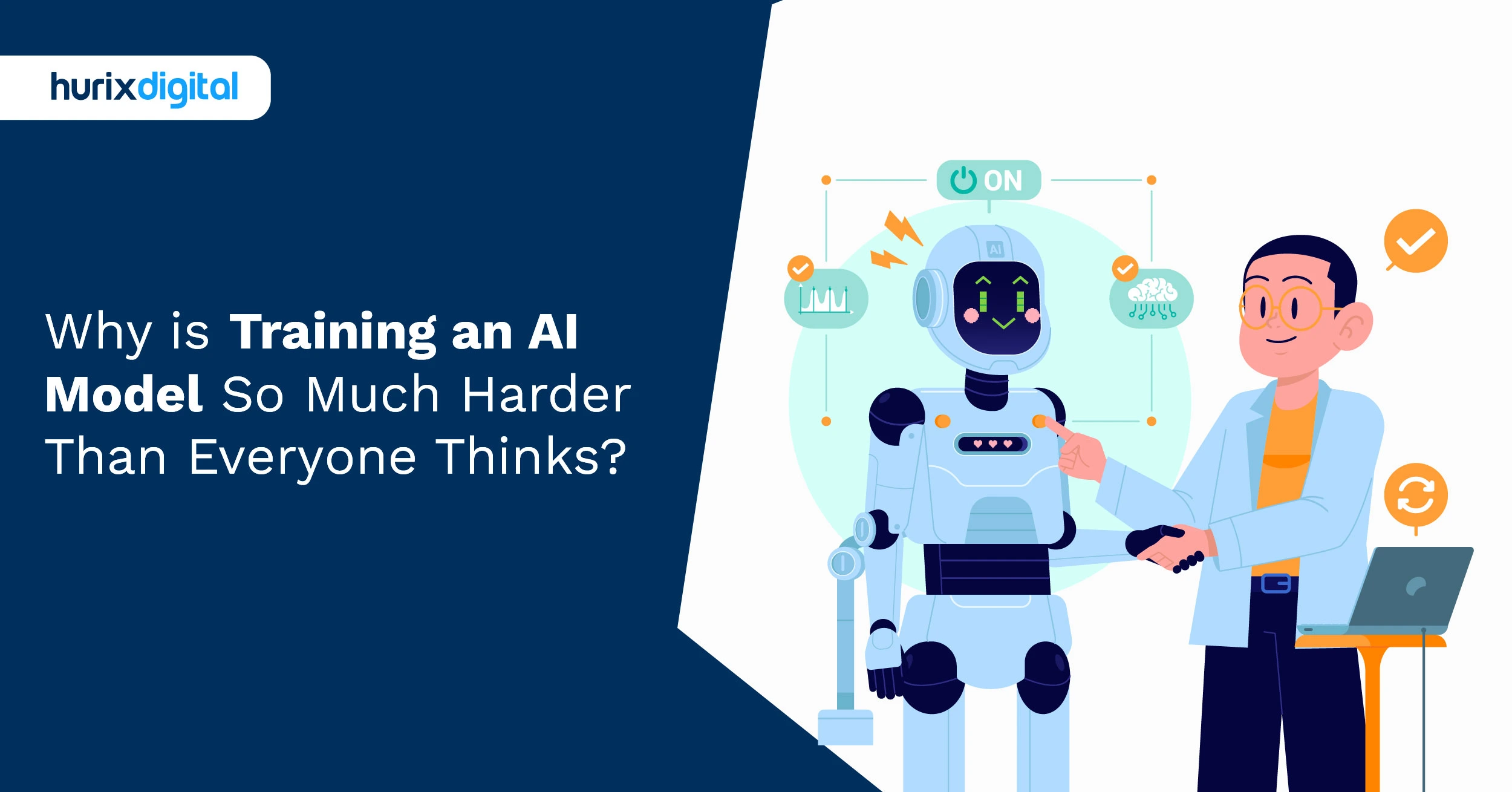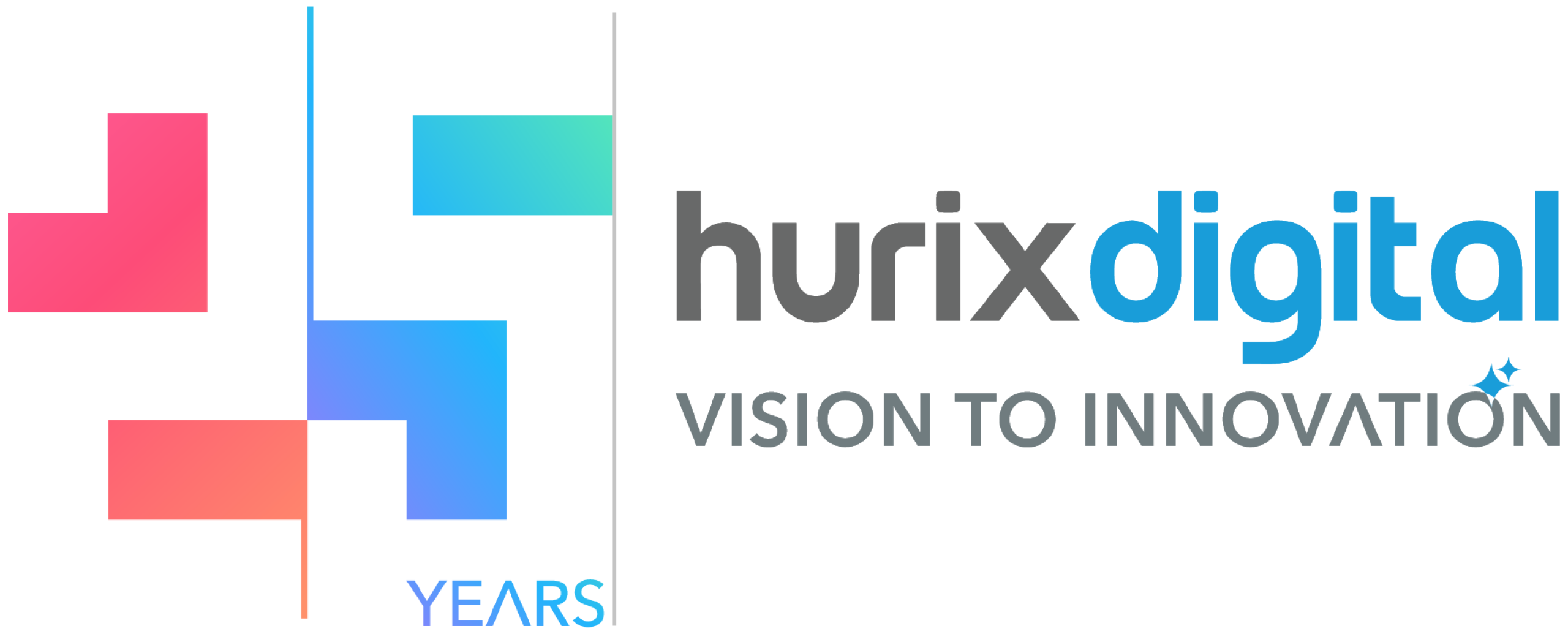
Why is Training an AI Model So Much Harder Than Everyone Thinks?
Everyone’s building AI these days. Or at least, everyone says they are. Walk into any tech meetup and you’ll hear the same buzzwords: machine learning, neural networks, transformers. What you won’t hear? The war stories. The disasters. The 3 AM panic attacks when your model starts hallucinating and nobody knows why.
We at Hurix Digital have been training AI models since before it was “cool.” Back when we called it machine learning, and people’s eyes glazed over at parties. These days, everyone wants to hear about artificial intelligence (AI). What they don’t want to hear is how mind-numbingly difficult it actually is to train models that work in the real world.
Here’s what happens. Some managers read about ChatGPT over breakfast. By lunch, they’re demanding their own AI. By dinner, some poor engineering team is googling “how to train a neural network” and wondering what they’ve gotten into. Six months later? Half-built prototypes, burned budgets, and a lot of uncomfortable meetings.
You don’t have to accept that, though. The difference between teams that ship working AI and teams that burn money? They understand what they’re really signing up for. They know the gotchas. They’ve learned (usually the hard way) that training an AI model is 10% inspiration and 90% dealing with absolute chaos.
So let’s talk honestly. No fluff, no vendor pitches, just real talk about what it takes to train AI models that actually work. Fair warning: some of this might make you reconsider that AI project. Good. Better to know now than discover it after burning through your budget.
Table of Contents:
- How Vital is High-Quality Data for Successful AI Model Training?
- How Do Leaders Prevent Inherent Bias in AI Training Data?
- How Can We Effectively Measure ROI on AI Model Training Investments?
- What are the Biggest Scalability Challenges in Large-Scale AI Model Training?
- How Do We Ensure Ethical AI Model Development and Deployment?
- How Can Organizations Overcome the Critical AI Training Talent Gap?
- What are the Best Practices for Robust AI Model Governance Frameworks?
- How Does MLOps Streamline and Optimize AI Model Training Pipelines?
- Why is AI Model Explainability Crucial for Senior Leadership Trust?
- How Can We Future-Proof Our AI Training Strategy for Evolving Technologies?
- Closing Thoughts
How Vital is High-Quality Data for Successful AI Model Training?
Garbage in, garbage out. The oldest rule in computing, and somehow everyone forgets it the moment AI enters the conversation.
Last year, we watched a retail client try training an AI model for a recommendation engine. They said they had “millions of data points. ” Impressive, right? Until we looked closer. Half their product descriptions were copied and pasted from manufacturers. Customer reviews included tests like “asdfjkl” and “nice nice nice nice.” Purchase histories had test transactions mixed with real ones. They’d been collecting garbage for years and calling it “data.”
Quality beats quantity every single time. It is better to have 10,000 clean, verified examples than 10 million questionable ones. Yet somehow, managers always want to hear about scale. “We have big data!” Sure, you have big something.
The painful truth? Most organizations don’t have AI-ready data. They have data-shaped objects that require months of cleanup before they’re useful. One financial services firm with which we worked discovered its “clean” transaction dataset included entries from 1970. Their model thought bell-bottoms were making a comeback!
What does quality actually mean? Consistency, for starters. If your data calls the same thing by seventeen different names, your model will too. Also, completeness counts. Missing values aren’t just gaps; they’re biases waiting to happen. Models learn that certain information “doesn’t matter” when really it was just missing.
The best teams treat data quality like a religious practice. They have data priests (okay, “engineers”) who bless every dataset before training an AI model. Validation rules that would make tax auditors jealous. One startup we consulted now spends more on data quality than on actual model development. Their competitors laughed. Then our models started outperforming theirs by a mile. Nobody’s laughing now.
Here’s my advice: before you train anything, audit your data like your life depends on it. Because your model’s life does.
How Do Leaders Prevent Inherent Bias in AI Training Data?
Bias is the skeleton in AI’s closet. Everyone knows it’s there, nobody wants to talk about it, and it jumps out at the worst possible moments.
I’ll never forget the healthcare AI that learned to diagnose skin conditions. It was impressively accurate on the test set. The model was deployed to clinics. Within weeks, complaints poured in. The model was terrible at recognizing conditions on darker skin. Why? The training data came from university hospitals in Minnesota, which are not exactly representative of global skin tones.
The insidious part? Nobody planned this. No evil mastermind decided to build a racist robot. Just well-meaning people using available data without thinking about what was missing. Bias works through absence, not malice.
Leaders love technical solutions to bias. “Can’t we just… remove it?” If only. We have watched teams apply every debiasing algorithm in existence and end up with models that are mathematically fair and practically useless. Perfect demographic parity sounds great until your model treats everyone identically, ignoring real differences that matter.
What actually works? Start with brutal honesty about your data sources. Who’s represented? Who’s missing? Why? We helped one e-commerce client discover that its training data skewed heavily toward urban customers. Rural users might as well have been aliens. Rather than fancy algorithms, they needed rural data.
Diverse teams help, but they’re not magic. We have seen homogeneous teams build fairer systems than diverse ones. The difference? Paranoia. They assumed bias everywhere and checked constantly. Diversity helps you spot problems, but vigilance keeps you honest. Our favorite bias detection method? Hire people to break your model. Pay them to find unfairness. One company we are in talks with employs sociology PhD students specifically to audit AI decisions. Expensive? Sure. Cheaper than lawsuits or newspaper headlines about discriminatory AI.
The uncomfortable truth is that you’ll never eliminate bias entirely. The goal is understanding your biases and managing them responsibly. Any leader who promises bias-free AI is selling snake oil or doesn’t understand their own system. Both are dangerous.
How Can We Effectively Measure ROI on AI Model Training Investments?
Measuring the return on investment (ROI) of AI is like nailing Jello to a wall. Messy, frustrating, and everyone watching thinks you’ve lost your mind.
We sat in a board meeting where the chief financial officer (CFO) demanded to know the exact return on their AI investment. The data science team had prepared slides with precision scores, F1 metrics, and AUC curves. The CFO’s response? “I don’t care about your acronyms. Did we make money?” Awkward silence followed.
Here’s the problem: AI value rarely shows up where accounting expects it. Fraud detection models prevent losses, not generate revenue. Similarly, the goal of a recommendation engine is not to cut costs, but to increase engagement. Traditional ROI calculations break down when benefits are indirect, delayed, or preventative. The successful measurements we have seen focus on business outcomes, not model metrics.
Time horizons complicate everything. That fraud detection model? There was no visible benefit from the deployment in the beginning; all costs were incurred. But six months later, fraud losses had dropped substantially. Two years later, insurance premiums decreased. Five years later, it had saved millions. But try explaining five-year ROI to quarterly-focused executives.
Hidden costs bite hard. Everyone budgets for GPUs and data scientists. Nobody budgets for the six months of data cleaning, the three failed experiments before finding what works, or the ongoing maintenance. One honest CTO told us that their AI project cost 3x the original budget. “But,” he added, “It’s worth 10x what we expected.” Both statements were true.
Our mantra would be to track everything, expect surprises, and tell multiple stories. The CFO gets efficiency metrics and cost savings. The CEO hears about competitive advantage and market positioning. The board sees strategic transformation. All true, just different lenses. There is more to AI ROI than just financial returns; it is also strategic, operational, and sometimes existential.
What are the Biggest Scalability Challenges in Large-Scale AI Model Training?
Scaling AI is where dreams meet physics. And physics usually wins.
A startup we consulted had a brilliant model. It worked perfectly with their pilot customer, and they signed ten more customers. Deployment day arrived. The model processed the first customer’s data in two hours. Quick math: ten customers, twenty hours. They had eight-hour SLAs. Panic ensued.
Scale breaks everything. Architectures that work for thousands of examples collapse at millions. That clever feature engineering pipeline? It’s now your bottleneck. The elegant neural network architecture? It won’t fit in memory anymore. Everything that made your prototype successful becomes a liability at scale in training an AI model.
Infrastructure costs scale non-linearly. Having double the data doesn’t mean you’ll have double the costs. It might even mean quadrupling them. One company’s cloud bill grew so fast that they literally ran out of approved budget mid-training. The model stopped learning at epoch 47 of 100. They never found out if it would have improved.
But infrastructure is the easy part. The hard part? Maintaining quality at scale. For small datasets, you can inspect them manually. But what about large datasets? Good luck with your efforts! We know teams that discovered critical labeling errors months after deployment. At scale, problems hide in statistics. That 0.1% error rate sounds tiny until you realize it’s affecting thousands of users.
How Do We Ensure Ethical AI Model Development and Deployment?
Ethics in AI is where good intentions meet unintended consequences, usually at high speed.
So, this company was building AI for hiring. Noble goal—remove human bias from recruitment. They trained on “successful employee” data. Seemed logical. The result? An AI that preferred candidates from the same three universities, with the same majors, with suspiciously similar extracurriculars. They’d automated bias, not eliminated it.
Ethical AI focuses on anticipating harm rather than following rules. And humans are incredibly creative at finding harmful uses for helpful tools. Is that chatbot designed for customer service? Someone will try to extract personal data. The efficiency optimizer? It might optimize away jobs. Every tool is also a weapon in the wrong hands.
Transparency helps, but it isn’t enough. One team built elaborate dashboards showing exactly how their AI made decisions. Users ignored them. Turns out people don’t want to read decision trees over breakfast. They want outcomes they trust from systems they understand. Big difference. So what works? Ethics committees with teeth, not rubber stamps. Including affected communities in design, not just deployment.
The hardest part? Saying no to profitable but problematic uses. We have seen companies that walked away from millions because the use case felt wrong. Others deployed first and apologized later. Guess which ones sleep better at night? Ethics isn’t a feature you add later. It’s a foundation you build on. Or don’t. But that choice defines everything that follows.
How Can Organizations Overcome the Critical AI Training Talent Gap?
Finding AI talent is like fishing in a pool full of people claiming they can swim. Most can’t. Some are drowning. A precious few are Michael Phelps.
The talent shortage is real, but it’s also self-inflicted. Everyone wants unicorns: PhD-level researchers who are also business-savvy, master communicators, and earn startup wages. Good luck. We have seen job postings requiring “15 years of deep learning experience.” Deep learning barely existed 15 years ago. We’re hunting for people who don’t exist.
University partnerships provide fresh perspectives and cutting-edge research. But manage expectations. That brilliant PhD student? They’ve never dealt with production systems, legacy data, or office politics. Pair them with seasoned engineers who’ve never published papers but know how to ship code. Magic happens at that intersection while training an AI model.
Remote work changed everything. Why compete with Silicon Valley salaries when you can hire brilliant minds from Prague, Bangalore, or Islamabad? One startup we are working with has AI engineers in seventeen time zones! Coordination is complex, but they get talent they couldn’t afford locally. Their secret? Asynchronous everything and documentation that would make Wikipedia jealous.
The real solution? Stop looking for unicorns. Build teams where collective intelligence exceeds individual brilliance. The best AI team I ever worked with had zero PhDs. But they had curiosity, collaboration, and a willingness to learn from failure. They shipped more working AI than teams with fancier degrees. Credentials matter less than capability. And capability can be developed.
What are the Best Practices for Robust AI Model Governance Frameworks?
Governance is what separates professional AI operations from expensive science experiments. Guess which one most companies are running?
Good governance starts with admitting AI is different. You can’t govern models like traditional software. Models are probabilistic. They drift. They decay often surprising you. Governance frameworks that ignore this reality fail spectacularly. Version control means more than Git commits. Which data trained this model? What preprocessing happened? Which hyperparameters? What validation results? We have seen teams recreate entire environments from six months ago to understand why a model changed behavior. Without proper versioning, that’s impossible.
Documentation is where good intentions go to die. Everyone agrees it’s important. Nobody wants to write it. The teams that succeed make documentation part of development, not an afterthought. Tools that extract metadata, generate reports, and track lineage are helpful. But human insight remains irreplaceable. Why did we make this choice? What alternatives did we consider? What assumptions might break?
The best governance frameworks feel invisible when things go well and invaluable when they don’t. They’re guardrails, not roadblocks. They enable fast, safe deployment rather than preventing it. Most importantly, they evolve. Static governance in a dynamic field is just tomorrow’s technical debt with better documentation. Robust governance is essential for training an AI model responsibly and at scale.
How Does MLOps Streamline and Optimize AI Model Training Pipelines?
MLOps is DevOps’s younger, more complicated sibling. The one that brings machine learning models to family dinners and makes everyone uncomfortable.
MLOps transforms that chaos into something resembling professional software development. It’s still messier than traditional code, despite “resembling” it. But at least it’s a systematic mess. Automation changes the game. A team automated the entire pipeline from data validation and model training to evaluation and deployment. What took weeks now takes hours. More importantly, it happens consistently. No more “works on my machine” disasters. The same process, every time, is documented in code.
Pipeline orchestration sounds fancy, but it’s just plumbing for AI. Data flows in, models flow out, and hopefully nothing leaks. The best pipelines handle failures gracefully. Dataset corrupted? Roll back and alert. Training diverging? Stop and investigate. Production metrics dropping? Automatic rollback. It’s like having a very paranoid assistant who assumes everything will break. They’re usually right.
Experiment tracking saves careers. Before: “I think I tried that architecture last month…” After: complete history of every experiment, searchable and comparable. We helped one automobile giant discover they’d been accidentally improving their model by testing on training data. For six months. Without tracking, they’d never have known. With it, they caught the error and fixed their process.
But tools aren’t the whole story. MLOps is mostly culture. It’s data scientists learning that notebooks aren’t production code. Engineers are accepting that models need different deployment patterns. Everyone agrees that manual processes don’t scale. The technology is mature. The mindset shift? That’s the hard part. But once teams make that shift, they wonder how they ever worked without it.
Why is AI Model Explainability Crucial for Senior Leadership Trust?
Show a CEO a black box that makes critical decisions and watch trust evaporate faster than startup funding in a downturn.
Leadership trust requires translation. In terms of market strategy and shareholder value, technical explainability-the importance of features, decision paths, and confidence intervals-means nothing. They need stories, not statistics. Narratives that connect model outputs to business outcomes.
The paradox perplexes everyone. Simple models that leaders understand often underperform. Complex models that work better resist explanation. One executive told me, “I’d rather have a comprehensible model that’s 80% accurate than a mysterious one that’s 95% accurate.” From their perspective, it makes sense. You can’t defend decisions you don’t understand.
What works? Progressive disclosure. Start simple: “Sales will likely drop because customer engagement decreased.” Want details? “Specifically, email open rates fell 30% and website visits halved.” Still curious? Here’s the full analysis. Most executives stop at level one. They just need confidence that someone understands the details.
How Can We Future-Proof Our AI Training Strategy for Evolving Technologies?
Future-proofing AI is like preparing for a hurricane while the weather keeps changing. You know something’s coming. You just don’t know what.
Five years ago, we used to advise companies to go all-in on convolutional neural networks. Two years ago, transformers changed everything. Last year, foundation models flipped the script again. Companies that bet everything on one approach got burned. Those who built flexible foundations? They adapted and thrived.
Technical flexibility matters, but organizational flexibility matters more. Teams locked into rigid processes can’t experiment with new approaches. Those with exploration budgets and innovation time? They’re already testing tomorrow’s techniques.
Data is the only constant. Algorithms change, frameworks evolve, but quality data remains valuable. Smart organizations invest more in data infrastructure than model architecture. They know today’s state-of-the-art model is tomorrow’s baseline. But that carefully curated, well-governed dataset? That’s gold regardless of which algorithm processes it during training an AI model..
The human element gets overlooked. Future-proof strategies require individuals who continually learn. Technical skills from two years ago are already dated. Teams that thrive have learning built into their culture. Participating in conferences, reading papers, and doing hands-on experiments are essentials, not extras, because the next breakthrough is probably being published right now!
Closing Thoughts
Here’s what a decade in AI has taught: Everyone wants the magic, nobody wants the mess. Training AI models isn’t a hackathon project or a quarter-long initiative. It’s a commitment to continuous learning, constant failure, and occasional breakthroughs.
The successful teams aren’t the smartest or best-funded. They’re the most honest about what they don’t know. They acknowledge that bias is inevitable, governance is essential, and explainability isn’t optional. And they invest in people, not just processors.
Discover how Hurix.ai supports your AI journey with expert data annotation, transformation, and curation services—helping you turn complexity into clarity. Ready to scale responsibly and excel at training an AI model? Visit hurix.ai and connect with us via our contact us page to get started.

Vice President – Content Transformation at HurixDigital, based in Chennai. With nearly 20 years in digital content, he leads large-scale transformation and accessibility initiatives. A frequent presenter (e.g., London Book Fair 2025), Gokulnath drives AI-powered publishing solutions and inclusive content strategies for global clients
 Upcoming Masterclass | Build an Army of Brand Evangelists using Training & Development | November 20th, 8:30 AM PDT | 11:30 AM EDT | 10:00 PM IST
Upcoming Masterclass | Build an Army of Brand Evangelists using Training & Development | November 20th, 8:30 AM PDT | 11:30 AM EDT | 10:00 PM IST
